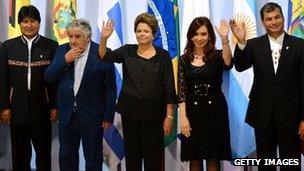'Gang of four' aims to shake up Latam trade
- Published

Businessman Juan Eduardo Errazuriz is in favour of the new alliance
In Latin American business circles, four countries are increasingly being mentioned in the same breath: Chile, Colombia, Mexico and Peru.
They are the founding members of the Pacific Alliance, the region's newest trade bloc. On Thursday, their presidents will meet in the Colombian city of Cali and are expected to sign a deal to scrap the majority of tariffs on trade between the four nations.
They will also discuss tax harmonisation and further convergence of their stock exchanges. They have agreed to drop visa requirements, allowing their citizens (more than 200 million people) to travel more easily between the four countries.
Since the Pacific Alliance was established last year, entrepreneurs and politicians have been gushing in their praise of it. Some regard it as the most exciting business development in the region for years.
"If you put them together, the four countries of the alliance would have the ninth biggest economy in the world, with around 2.7% of global GDP [gross domestic product]," says Juan Eduardo Errazuriz, a Chilean businessman. "They account for half of all Latin American trade with the rest of the world."
Mr Errazuriz, chairman of construction company Sigdo Koppers, which operates in all four countries, is not the only one bigging-up the alliance.
Costa Rica and Panama want to join it. Countries as diverse as Canada, Japan, New Zealand and Uruguay have asked for observer status. Even Spain, not known for its Pacific coastline, says it wants to get involved.
Another talking shop?
At first glance, Latin America needs another regional talking shop like it needs a hole in the head. It already has plenty of them.
There is Mercosur, a trade bloc dominated by Argentina and Brazil; and there is Alba, the left-wing brainchild of Venezuela's late-President Hugo Chavez.

Latin America already has a number of regional trade bodies
There is the Can (the Community of Andean Nations); and there are Unasur and Celac, two relatively new regional bodies committed to greater regional integration.
As if Latin America needed another acronym, about a dozen countries on both sides of the Pacific, including Chile, Mexico and Peru, are negotiating a new trade agreement, the Trans-Pacific Partnership (TPP).
But it is the Pacific Alliance that seems to have captured the imagination of the business community due to the dynamism of its member economies.
The Peruvian and Chilean economies were the fastest growing in South America last year, expanding by 6.3% and 5.6% respectively. The Colombian and Mexican economies grew more slowly but still outstripped the regional average.
All four countries are outward-looking, with a particular interest in Asian markets. Chile has more free trade agreements in place than any other country in the world, and Mexico is not far behind.
Bogged down
Compare that with Latin America's other major trade bloc, Mercosur.
It was set up in 1991 by Argentina, Brazil, Paraguay and Uruguay, and after showing initial early promise has since become bogged down.
Argentina has put up more and more protectionist trade barriers, while Venezuela has brought a left-wing agenda to the bloc since gaining membership in 2012.

DBS is outgrowing the Chilean cosmetics market
Mercosur's failure to agree a free-trade agreement with the European Union is indicative of its shortcomings. The two sides have been discussing one off and on for the past 18 years.
Faced with the difficulties of doing business in countries such as Argentina and Venezuela, companies in Chile, Colombia, Mexico and Peru are venturing into each other's markets.
Chilean retail firms, for example, now account for 9% of retail sales in Peru and 4% in Colombia. Falabella, one of Chile's biggest department stores, brings in about 20% of its revenue from Peru.
"Peru and Colombia are the natural markets for us to go next," says Dominique Rosenberg, chief executive of Chilean beauty products company DBS.
Founded just seven years ago, DBS is already outgrowing the relatively small Chilean cosmetics market and plans to expand into Peru and Colombia over the next two years.
Ms Rosenberg describes the Pacific Alliance as an interesting development for any company exporting between the four member states.
Room to grow
Despite the increased integration between the alliance countries, there is still scope for much more.
Mr Errazuriz estimates that only 7% of Chile's total trade goes to the other three countries of the alliance, and that only 3% of foreign direct investment flowing into Chile comes from Colombia, Mexico and Peru.
"That suggests there's room to grow in both directions," he says.
Latin America has a long history of talking about regional integration but often it has not amounted to much. Despite common cultures and languages, its nations have tended to view each other as rivals in trade rather than partners.
But that is starting to change, with inter-regional trade on the rise. The Pacific Alliance looks set to be part of that transformation.